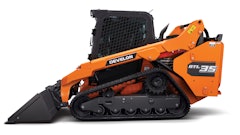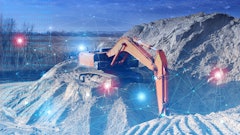
With cold, harsh weather still persistent throughout the country, construction workers should consider wearing proper workwear to prevent hypothermia. Cold stress is highly risky, affecting one's ability to conduct basic tasks on the jobsite.
Trevor Hall, an associate solicitor at social law firm Thompsons Solicitors, deals with serious injuries and military cases with a specialization in non-freezing cold injuries. Hall notes that trench foot is a non-freezing cold injury (NFCI) that not only affects a person’s foot, but also their hands when exposed to temperatures slightly above freezing.
Freezing conditions can also lead to other types of cold injuries such as hypothermia and frostbite. NFCIs produce lifelong symptoms. Once sustained, the sufferer should avoid prolonged cold exposure indefinitely, which could effectively end a construction worker’s career, notes Hall.
Signs of Hypothermia
Cold stress occurs by driving down the skin temperature, and eventually the internal body temperature. When the body is unable to warm itself, serious cold-related illnesses and injuries may occur, and permanent tissue damage and death may result.
Signs of hypothermia include shivering, slurred speech or mumbling, slow and shallow breathing, a weak pulse, clumsiness, confusion or memory loss, drowsiness and loss of consciousness. Hypothermia can lead to death.
The Occupational Safety and Health Administration (OSHA) notes that cold stress can be prevented when employers know the wind chill temperature so that they can gauge workers’ exposure risk better and plan how to safely do the work.
It is also important to monitor workers’ physical condition during tasks, especially new workers who may not be used to working in the cold, or workers returning after spending some time away from work.
The National Oceanic and Atmospheric Administration (NOAA) Weather Radio is a nationwide network of radio stations broadcasting continuous weather information from the nearest National Weather Service office and gives information when wind chill conditions reach critical thresholds.
The NWS Wind Chill Calculator is a tool where one may input the air temperature and wind speed, and it will calculate the wind chill temperature.
Environmental cold can affect any worker exposed to cold air temperatures, putting them at risk of cold stress. As wind speed increases, it causes the cold air temperature to feel even colder, increasing the risk of cold stress to exposed workers.
Risk factors for cold stress include wetness/dampness, dressing improperly, and exhaustion. Predisposing health conditions include hypertension, hypothyroidism and diabetes and poor physical conditioning.
Protecting Workers from Cold Hazards
Under the Occupational Safety and Health Act (OSH Act) of 1970, employers have a duty to protect workers from recognized hazards, including cold stress hazards, that are causing or likely to cause death or serious physical harm in the workplace.
Training workers should include how to recognize the environmental and workplace conditions that can lead to cold stress; cold stress symptoms, how to prevent cold stress, and how to help those affected, and how to select proper clothing for cold, wet, and windy conditions.
Employers should monitor workers, provide engineering controls such as radiant heaters, gradually introduce workers to the cold, and schedule adequate and sufficient breaks in warm areas.
Workers can protect themselves and others by knowing the symptoms, monitoring themselves and co-workers, drinking warm, sweetened fluids (no alcohol).
OSHA has a site has instructions for how to help workers suffering from cold stress such as hypothermia.
Cold stress can be prevented with the proper construction workwear, including PPE. Workers should cover up, dress in layers (but avoid layers restricting movement), stay dry and avoid activities that cause them to over-exert themselves.
Proper PPE for Cold Weather
It’s important for employers to provide adequate PPE to workers who are not working in an appropriately heated environment due to the nature of their work. PPE not only includes clothing that covers the trunk and legs, but also insulated boots and gloves.
Water-repellent outerwear and a base layer made of moisture-wicking material helps keep workers dry by moving moisture caused by sweat to the clothing’s surface and away from the skin. Some clothing protects against dual-hazards such as Magid’s Dual-Hazard Duck Outerwear which offers arc flash and flash fire protection along with protection from the cold, wind, and water.
Heated jackets offer proactive protection against cold stress. Check out this IRONPROS article for a selection of heavy-duty heated jackets for construction sites.



























